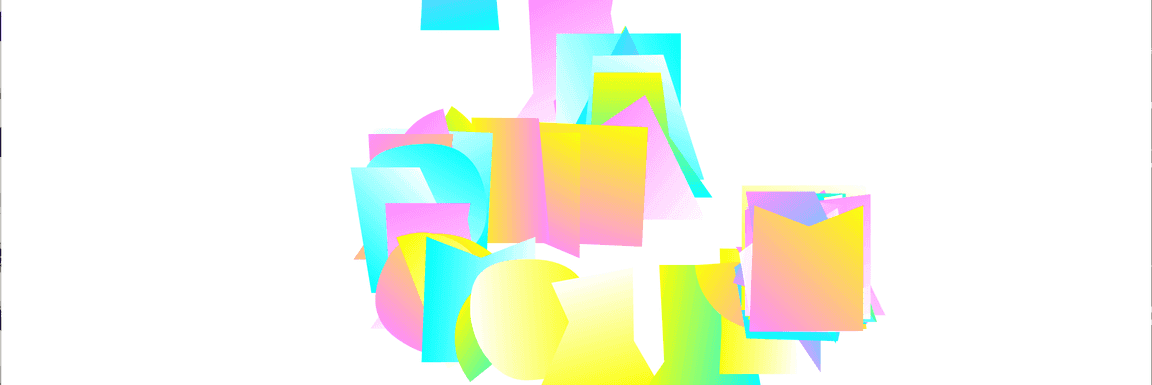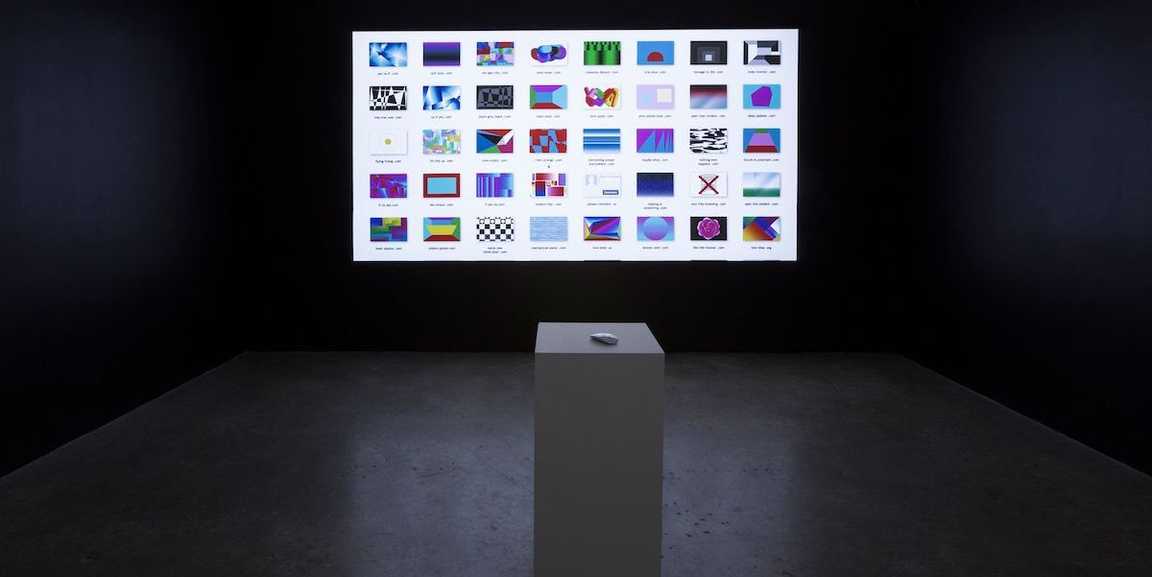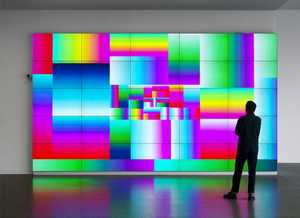
fillthisup.com (2014) - Rafaël Rozendaal
In the collection of KRC.
The main challenge is related to the preservation of its distribution over the internet and how interaction can be mapped and the related technology preserved. At the start of the project, information abounded concerning how the work should be shown in a gallery setting, in a way that encourages interaction.
Brief Description of the Work
fillthisup.com is an internet artwork that turns the browser into canvas upon which we can drag our cursors around. fillthisup.com (JavaScript and HTML5) consists of an interactive webpage programmed by Reinier Feijen. When the visitor first loads the website, it appears blank until the cursor is moved into the browser window, at which point shapes in brightly colored gradients begin to rapidly stack up following the cursor. Once the shapes are laid down, they become part of a non-dynamic bitmap, which can only be altered by adding more shapes or dragging the cursor, which changes the color of the shapes to white and acts as a de facto eraser.
Gallery versus Hotel Presentation
The KRC Collection regularly loans their works to the international conglomeration of CitizenM hotels prompting questions how the work could be presented in a way that inspires interaction in a hotel space. At the start of the project, information abounded concerning how the work should be shown in a gallery setting, but discussion with the artist over how best to present the work in any of the CitizenM hotels continued to reach a dead end.
Prior to acquisition in 2014, the work had been shown just one time as part of a solo exhibition titled “Almost Nothing Hardly Anything” (November 1st - November 29th, 2014) at Steve Turner Contemporary in Los Angeles. How fillthisup.com was shown at this exhibition followed many of the display specifications detailed by the artist regarding gallery presentation. These include the use of a projection that fills the space, exhibition of the work without the browser window and the inclusion of a pedestal holding a means by which to interact with the work. The only way in which they differ is the use of a mouse instead of the touchpad suggested by the artist.

Overview showing how Rozendaal's internet artworks were installed, on the screen is the artist's website waiting for the viewer's selection
Three years later in 2017, fillthisup.com experienced its first presentation in a hotel, in the form of CitizenM’s New York Times Square location. Here it was presented in the hotel’s rooftop bar where it was displayed on a Samsung flat screen utilizing an iPad, which was passed between bar customers to promote user interaction. Regarding this presentation neither the institution nor the artist were satisfied. The artist described his dissatisfaction as stemming from the lack of interest and interactivity inspired by the space in which it was shown.
Achieving the Artist’s Desired Hotel Presentation
Considering the artwork’s exhibition history and the artist’s specific instructions for the display of his interactive websites, the question was how to bridge the gap. In the interview with Haverkamp and Rozendaal, a compromise was reached that met the artist’s desires to promote interactivity with the work as well as the capabilities of the suggested display spaces.
This compromise took the form of presenting fillthisup.com on the built-in, large-scale touch screens found in some elevators at CitizenM hotel locations. Since the default color of these touch screens is a metallic black, the artist said that the background of the work could be changed to black, and not be considered a different version, only a different presentation. Rozendaal said that the artwork could easily be shown in more than one location at once, as duplicate presentations reflect the artist’s concepts of 24/7 accessibility. To promote interaction, which was lacking in the work’s earlier hotel presentation, the artist suggested that Feijnen could write a script that would create a random line of shapes, showing visitors how to interact with the work. Further, the typical three-minute-or-so elevator ride a visitor normally would take would provide more than enough time to get a grasp of and play with the work. The artist’s considerations regarding the work and its presentation can be summarised in his own words: “it just has to feel fun. If it doesn’t feel fun, it’s no good.”
Considering the Long-term Preservation
During the initial interview with the artist, it also became apparent that there was another version of the work that had been created in Adobe Flash (end of life 2020). Only at the end of the case study process, it became clear that this version had never been online by checking his logs, changing the status of this set of files from “version” to “draft.” This therefore required an adjusted approach whereby LI-MA does not retain these files but instead only those that compose the work and are related most directly to its functionality. These files, which include the source code for the work, LI-MA stores on both Gitlab as well as on ArtHost.
Other than this work specifically, Rozendaal is suggesting that other institutional owners of his works follow suit and upload their works of his to ArtHost. From this point on, LI-MA will serve as host, utilising virtual machines to meet the needs of each artwork, while protecting and promoting the works’ accessibility. LI-MA’s service also maintains the domain name, which in this case, as with many net artworks, provides the work with its title. This ensures the long-term preservation and accessibility of all of Rozendaal’s net artworks.
Access to the case study report, interview, and object-related documents is available on request (info@li-ma.nl).
Research completed by LI-MA team in collaboration with: Rafaël Rozendaal (Artist), Floor Haverkamp (Curator, KRC Collection) and Paula Fernández Valdés (PhD University Politecnica Valencia, Intern, LI-MA)








